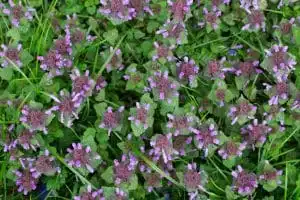Ground ivy (Glechoma hederacea), while technically not considered an invasive plant, is known by amateur gardeners, lawn-care professionals, and property owners alike as one of the most difficult perennial weeds to control. This unwelcome guest spreads quickly to form a dense carpet, often crowding out the plants or grasses you have chosen to grace your yard.
Also known as creeping Charlie, alehoof, cat’s foot, field balm, gill-over-the-ground, and runaway robin, this persistent ivy was introduced to North American soil with the first settlers and used for both ornamental and medicinal purposes. Although it is common in moist or disturbed locations and prefers shady areas, the non-native perennial can also thrive in sunny spots.
Identifying Ground Ivy
One of the first plants to flower in the spring, ground ivy sports tiny, blue-violet flowers that cluster in groups of three atop squarish stems. The heart or kidney-shaped leaves of the plant have scalloped edges. Ground ivy is a member of the mint family, so it gives off a mild, minty scent when the leaves are crushed or mowed. But probably its most notorious characteristic is its system of trailing stems that give the plant its creeping reputation. Nodes on the stems allow the plant to root into the soil in multiple locations, making it hard to weed out the entire plant without some of it surviving and re-populating. The low-creeping nature of the plant also helps it to survive a pass from the lawn mower.
Ground Ivy Prevention and Control
If you catch ground ivy in the early stages, you may be able to remove it by hand, but weeding will only be successful if it’s in a small area, and you have to completely eradicate the entire root system, otherwise, it will just come back. Weeding is best done when the soil is slightly moist and loose, like after a light rain—be prepared to repeat the process. As soon as possible, reseed the areas in the lawn where you’ve removed ivy, or other weeds may pop up to take its place in the sparse grass.
Ground ivy can sometimes be successfully destroyed by using a broadleaf weed control, but time is of the essence. It needs to be applied in the spring and fall, and keep in mind you need to repeat the process the following year. When applying the treatment, only lightly coat the ivy leaves—don’t let it soak into the soil as it may damage or destroy other plants or grasses.
Because ground ivy thrives in disturbed areas, sparse lawns, and shady locations, keeping your lawn healthy can keep you one step ahead of an infestation. Chances are, if the ivy is doing well in your lawn, your grass is probably not in good shape. The best way to deter this weed from taking over is proper lawn care—trim trees to increase sunlight and water, fertilize, and mow grass regularly. Also, fix any drainage problems and test the acidity of your soil. Unfortunately, this persistent weed is hard to eradicate completely, so your best bet is to control it as much as possible or call in a lawn-care professional.
To learn more about managing ground ivy or other unwanted weeds, contact Free Spray Lawn Care at 419-529-5296.



Comments (0)
Thanks for your comment!
Thanks for your feedback! Your comments have been successfully submitted! Please note, all comments require admin approval prior to display.
Error submitting comment!
There is a problem with your comment, please see below and try again.